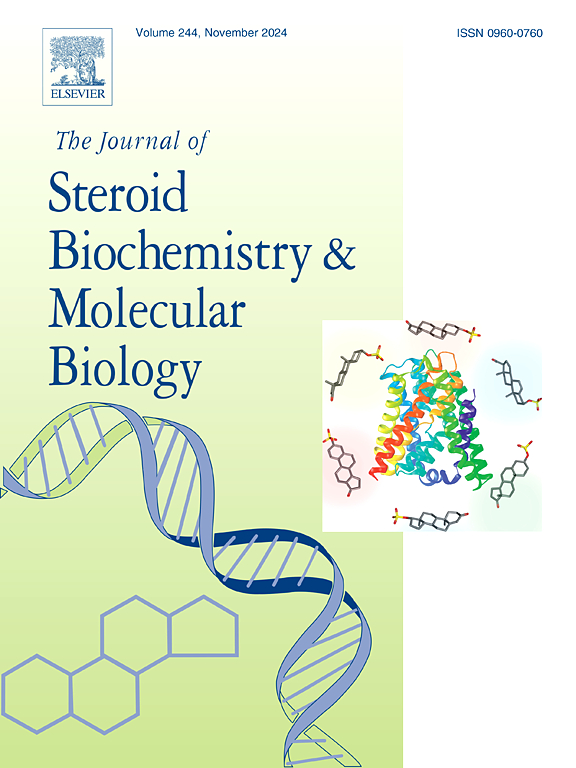矿皮质激素受体阻断治疗实验性自身免疫性脑脊髓炎小鼠的益处
IF 2.5
2区 生物学
Q3 BIOCHEMISTRY & MOLECULAR BIOLOGY
Journal of Steroid Biochemistry and Molecular Biology
Pub Date : 2025-08-23
DOI:10.1016/j.jsbmb.2025.106844
引用次数: 0
摘要
对矿化皮质激素受体(MR)作用的研究表明其在先天和适应性免疫反应中起作用。在心血管疾病、自身免疫、慢性肾脏疾病和肥胖等多种疾病中,炎症谱与MR激活直接相关。MR是一种结合矿皮质激素和糖皮质激素的高亲和力受体。在这项研究中,我们探讨了矿化皮质激素激动剂脱氧皮质酮(DOCA)和拮抗剂螺内酯(SPIRO)对多发性硬化症实验性自身免疫性脑脊髓炎(EAE)模型小鼠血浆皮质酮水平、神经炎症、髓磷脂状态和脊髓神经退行性变的药理学调节。诱导后第1天至第17天处死,实验组分为EAE+DOCA(0.75 mg/kg s.c / 3 d)、EAE+DOCA+SPIRO(螺内酯:25 mg/kg i.p / d)、载药EAE (EAE+VEH)和对照组(CTRL)。对EAE给予DOCA或载药可引起类似的神经病理改变。MR拮抗剂(a)显著降低炎症参数TLR4、IL-1β和小胶质细胞CD11b mrna,并有降低骨桥蛋白的倾向;b)与EAE+DOCA相比,降低了细胞渗透和脱髓鞘面积的百分比,以及反应性胶质瘤(GFAP+面积和IBA1 +细胞数量);c)与EAE+DOCA和EAE+VEH组相比,增加了神经元标记物NeuN的面积;d)与EAE+DOCA组相比,改善了rotarod试验的功能表现和临床症状。有趣的是,与对照组相比,EAE+VEH和EAE+DOCA组血浆皮质酮水平升高,而SPIRO组提高的皮质酮水平更高。这种高皮质酮血症具有功能性后果,因为糖皮质激素受体(GR)和靶基因血清糖皮质激素调节激酶1 (SGK1) mrna的表达也比单独使用DOCA增加。我们假设SPIRO的MR阻塞下调了炎症相关的脊髓病理,而EAE+DOCA+SPIRO组中循环的过量糖皮质激素可能有助于抗炎作用。本文章由计算机程序翻译,如有差异,请以英文原文为准。
The benefit of mineralocorticoid receptor blockade in the treatment of experimental autoimmune encephalomyelitis mice
Research on the effects of the mineralocorticoid receptor (MR) suggested a role in innate and adaptive immune responses. The inflammatory profile is directly linked to MR activation in several pathologies such as cardiovascular diseases, autoimmunity, chronic renal disease and obesity. MR is a high-affinity receptor binding both mineralocorticoids and glucocorticoids. In this study, we explored the pharmacological modulation of MR with the mineralocorticoid agonist deoxycorticosterone (DOCA) and the antagonist spironolactone (SPIRO) on corticosterone levels in plasma, neuroinflammation, myelin status and neurodegeneration in the spinal cord of mice with experimental autoimmune encephalomyelitis (EAE) model of Multiple Sclerosis. Animals were treated from day 1 until sacrificed on day 17 post-induction, and experimental groups were divided into: EAE+DOCA (0.75 mg/kg s.c every 3 days), EAE+DOCA+SPIRO (Spironolactone: 25 mg/kg i.p daily), vehicle-treated EAE (EAE+VEH) and Control (CTRL). Administration of DOCA or vehicle to EAE conducted to similar neuropathological alterations. The MR antagonist (a) significantly decreased inflammatory parameters TLR4, IL-1β and microglial CD11b mRNAs and showed a tendency to reduced osteopontin, b) reduced the % of infiltrated cellular and demyelinated area, as well as the reactive gliosis (GFAP+ area and number of IBA1 + cells) vs EAE+DOCA (c) increased the area of the neuronal marker NeuN vs EAE+DOCA and EAE+VEH groups (d) improved functional performance in the rotarod test and clinical signs vs EAE+DOCA. Interestingly, plasma corticosterone was increased in EAE+VEH and EAE+DOCA vs CTRL, while SPIRO administration raised even more corticosterone levels. This hypercorticosteronemia had functional consequences, because the glucocorticoid receptor (GR) and the target gene serum glucocorticoid regulated kinase 1 (SGK1) mRNAs expression were also increased vs DOCA alone. We hypothesized that MR blockage with SPIRO downregulated inflammation-related spinal cord pathology whereas excess glucocorticoids circulating in the EAE+DOCA+SPIRO group may contribute to anti-inflammatory effects.
求助全文
通过发布文献求助,成功后即可免费获取论文全文。
去求助
来源期刊
CiteScore
8.60
自引率
2.40%
发文量
113
审稿时长
46 days
期刊介绍:
The Journal of Steroid Biochemistry and Molecular Biology is devoted to new experimental and theoretical developments in areas related to steroids including vitamin D, lipids and their metabolomics. The Journal publishes a variety of contributions, including original articles, general and focused reviews, and rapid communications (brief articles of particular interest and clear novelty). Selected cutting-edge topics will be addressed in Special Issues managed by Guest Editors. Special Issues will contain both commissioned reviews and original research papers to provide comprehensive coverage of specific topics, and all submissions will undergo rigorous peer-review prior to publication.

 求助内容:
求助内容: 应助结果提醒方式:
应助结果提醒方式:


